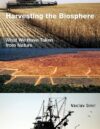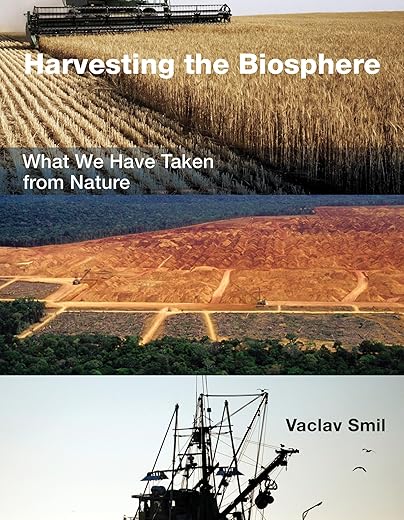
€25.00
Harvesting The Biosphere: What We Have Taken From Nature By Vaclav Smil Price comparison
Harvesting The Biosphere: What We Have Taken From Nature By Vaclav Smil Price History
Harvesting The Biosphere: What We Have Taken From Nature By Vaclav Smil Description
Harvesting The Biosphere: What We Have Taken From Nature by Vaclav Smil – Your Guide to Nature’s Impact
Discover the depths of our relationship with nature in Harvesting The Biosphere: What We Have Taken From Nature by Vaclav Smil. This enlightening book, published by The MIT Press in a reprint edition on August 21, 2015, brings a captivating view of environmental science to readers. Spanning 320 pages, this paperback edition highlights the complex interactions between humans and the biosphere, making it a must-read for anyone interested in ecology and sustainability.
Key Features of Harvesting The Biosphere
- In-Depth Analysis: Smil examines the vast resources extracted from the biosphere, providing readers with a thorough understanding of ecological impact.
- Readable and Accessible: Written in English and structured for easy comprehension, this book invites readers from diverse backgrounds to explore complex ideas.
- Comprehensive Research: With an ISBN-10 of 0262528274 and ISBN-13 of 978-0262528276, this book is based on meticulous research and real-world examples.
- Compact and Portable: Its dimensions of 6.75 x 0.65 x 8.81 inches and a weight of 1.05 pounds make it easy to take anywhere.
- Rich Content: Enjoy 320 pages filled with insights that stimulate thought and debate about our ecological footprint.
Benefits of Reading Harvesting The Biosphere
This book provides essential insights into how humanity has shaped nature through resource extraction. Here are some benefits of diving into this compelling read:
- Broaden Your Understanding: Gain a deeper insight into the biosphere and the impact of human activity on natural ecosystems.
- Engage in Important Discussions: Spark conversations about sustainability and ecological conservation in today’s context.
- Empower Your Choices: Make informed decisions regarding consumption and environmental responsibility based on Smil’s findings.
Compare Prices Across Different Suppliers
When looking to purchase Harvesting The Biosphere, it’s essential to compare prices from various suppliers. Prices may vary considerably based on location and platform. Reviewing our price comparison tool can help you find the best deal available for this insightful book.
Check out the price trends over the last six months. The analysis demonstrates how the demand fluctuated, influencing the retail pricing of this vital publication. Historical data indicate a consistent interest in Smil’s works, with slight spikes aligning with environmental discussions in the media.
Insights from Customer Reviews
Reader feedback on Harvesting The Biosphere has been largely positive, citing the book’s depth and clarity. Many appreciate Smil’s ability to break down complex subjects and deliver them in a structured manner. Positive reviews often highlight the author’s unique perspective, enriching the reader’s understanding of the ecological challenges we face.
However, some readers noted a few drawbacks, such as its dense informational content, which can be overwhelming for those new to environmental studies. Nevertheless, the overall consensus suggests that the book is an invaluable resource for gaining insights into our interactions with the natural world.
Related Unboxing and Review Videos
For those who prefer visual content, several unboxing and review videos are available online. These videos dive deeper into the themes of Harvesting The Biosphere and provide additional context for readers. Check them out to enhance your reading experience and to see what other readers are saying about the content!
Final Thoughts on Harvesting The Biosphere
In conclusion, Harvesting The Biosphere: What We Have Taken From Nature by Vaclav Smil is not just a book; it’s a crucial tool for understanding the impact of human actions on our environment. Its comprehensive research and accessible writing style make it suitable for varied readerships, from casual enthusiasts to dedicated scholars.
Don’t miss your chance to explore Vaclav Smil’s impactful insights. Compare prices now!
Harvesting The Biosphere: What We Have Taken From Nature By Vaclav Smil Specification
Specification: Harvesting The Biosphere: What We Have Taken From Nature By Vaclav Smil
|
Harvesting The Biosphere: What We Have Taken From Nature By Vaclav Smil Reviews (12)
12 reviews for Harvesting The Biosphere: What We Have Taken From Nature By Vaclav Smil
Only logged in customers who have purchased this product may leave a review.








C. Bensen –
I didn’t know this was going to be a textbook, but it is a comprehensive guide to calculating how much life we have on our earth, and how much we take it.
Great book for anyone seriously interested in the science behind our modern society.By serious I mean you’re a masters student or professor. This is NOT a bedtime read.
Stephen C. Baer –
If you are interested in who we are and what we have been doing for millennia, read this book. The subtitle, “what we have taken from nature” sets a tone of these remarkable 300 pages. Smil has his doubts about us. Who wouldn’t?
In some pages I find the tone of Scientism, the substitution of scientific jargons for what could be said more simply. Why be restricted to his prefixes when quantities could be spelled out even stated several ways for instance T remains mysterious to me until I look up that it stands for 1012, a million million or terra. Has Smil done this on purpose to jar us into a fresh look? Like a hard hat on a construction site is his language stilted for good reason?
What keeps me reading Smil after finishing most of his 30 books is the freshness of his observations, how surprising he is. An author with an identifiable agenda becomes tiresome, not Smil. Every topic, as “did early man kill off big game”, draws an original stream of references, quantities and questions. How can he refer to so many books and journals without ever seeming bookish? Facts and statistics reported by this omniscient guide blend into an unfinished song or poem not a library shelf.
The wonder is in Smil’s original look at things. Can’t he ever learn “to play ball” he must infuriate colleagues. Imagine him comparing how the satellites see his home town, Winnipeg to what he knows better. And can he really suggest that now and then man gives to Nature? Wasn’t his theme just the opposite?
This extensive study of man becoming the dominate, horrifying force throughout the planet, plowing up North America, Brazil, China and everywhere else, straining the vast oceans through our fishing nets, is alarming. We can stop and consider, before we sink into despair, that along with many degradations we have also produced a Smil.
Steve Baer
William Carpenter –
Vaclav Smil’s Harvesting the Biosphere: What We Have Taken from Nature is not an easy book to read. It is full of statistics such as this excerpt: (… 15MJ/kg for grains and more than 16MJ/kg for fatty meat). Despite this, the book is fascinating!
Smil analyzes the mass of the biosphere, i.e. all of the Earth’s life including plants, animals, and other living matter. He calculates how much of this living matter there is and how much of that total is used by humans. He also, incidentally, imparts really interesting tidbits about the extinction of mammoths and other megafauna, the importance of forests, the impacts of whaling, and lots of other interesting topics. It seems that we still haven’t learned how to handle fire – one of the largest human impacts on the world historically has been the burning of forests – much of which was and is accidental.
In this period of uncontrolled global warming, one might expect the author’s conclusions to be uniformly pessimistic. Smil surprises with a somewhat optimistic final chapter on long-term trends. He ends with a set of recommendations, well supported by the evidence in this book, that we need to stabilize our global population, eat less meet, waste less food, share the world’s resources more equitably, and manage the demand for wood. I hope we listen to him!
Adriano –
Autor une rigor academico a um texto agradável e fluido. Texto muito interessante para um tema atual e crítico (meio ambiente)
Pertti Ranta –
Amazing, filled with insigthfull information
Chad M –
This book is laden with facts and milestones about the biosphere. Here are some of the highlights of Prof. Smil’s book:
a. about 40% of all of terrestrial phytomass – trees, brush, grass – has been removed. To me, this paints of picture of a world heading toward unprecedented desertification. Even at this figure, the world is rapidly clearing and burning the tropical rainforests;
b. the ocean’s zoomass or animal matter is perhaps that most vulnerable area in next few decades, according to the author. This is well described in the final chapter;
c. biomass harvests for biofuel, using so-called crop waste, imperils the health and water-absorbing capability of soils. Biomass fuel is not a good answer at large scales.
d. land and ocean mammals are at 10% of historic levels, for many species. More ocean and land disruptions will imperil the final 10% of remarkable fellow mammals.
Harvesting the biosphere, crowding out the diversity of life, and the road to global desertification. Can it be turned around? Prof. Smil offers impartial and practical advice in the last chapter. This book complements the author’s other excellent books. Hopefully the summary and concluding chapter of this book will be shared among many educated people in the world.
The Gates Foundation is listening to Prof. Smil. Also, Bill Gates is personally a fan of Smil’s books. How many other major foundations and think tanks are paying attention?
On a final note, this book makes it clear that human civilization’s strategy of natural resource exploitation combined with indefinite population growth is a culture that is thousands of years old and unfortunately one that is archaic, worn-out, and now obsolete. Periodic surges and collapses of society’s have occurred, and now Jared Diamond observes that a near global collapse may be a few decades away. The world needs a new vision of humanity living in symbiosis with the natural world, improving some areas and utilizing specific designated areas, instead of the other way around where protected areas are the exception rather than the rule. Understanding the need for a civilization-biosphere symbiosis is just the beginning of an effort by scientists to formulate and promote such a new civilizational strategy.
Max Kummerow –
Smil has written a number of books about human impact on the planet. This one is summed by by the calculation that about 99% of land vertebrate biomass on earth consists of humans and their domestic animals. The aim of the book is to examine how much of the earth’s biological productivity humans use. This suggests how much further human economies and food supplies can increase. The limits to growth are clearly in sight–in fact, we already use enough to seriously destabilize the very systems that support us. The science is pretty solid, which makes it a slog in places, but I like the fact that this book makes a serious attempt to get the science right by looking at these questions carefully.
Thales –
The book has not met my expectations. I was looking for an easy explanation of what we take from the earth and what we should do to insure our food for the future with the coming growth of population. Some of this information was available but in a really academic way.
emil gigov –
I enjoyed one of his previous books (on the Oil industry) but this one is really dry with little commentary and too many stats from obscure studies
Amazon Customer –
An incredible interesting book
M Burkhart –
Good book, thought provoking, I have not yet finished it, but like it very much, and will definitely re read
Russell –
a very scientific read, recommended for high level readers, yet still important.